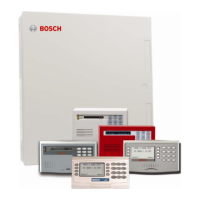D7212GV3 | Program Entry Guide | 4.0 Points EN | 89
Bosch Security Systems, Inc. | 10/11 | F01U170808-02
Use the P## Swinger Bypass parameter to allow the
control panel to bypass automatically a point that
reports two or more alarm or trouble events within the
same arm cycle. The maximum number of faults
allowed on a point is set in the Swinger Count
prompt (refer to page 125).
The control panel reports a Swinger Bypass when the
Swinger Count is reached and P## Report Bypass
at Occurrence is set to Yes. If the point has a partial
count (less than the Swinger Count number of events
during an hour), the count is reset to zero.
P## Bypassable does not need to be
programmed as Yes for swinger bypass
to work.
A Swinger Shunted point returns to the
system if P## Bypass Returnable? Is
Yes. If not, return the point to the system
through manual unbypass or
[COMMAND][0][0]. Refer to P## Bypass
Returnable on page 88 for additional
information.
P## Report Bypass at Occurrence
Default: No
Selection: Yes or No
Yes Send a Command Bypass Report
when the point is bypassed.
No Do not send a Command Bypass
Report when the point is bypassed.
Send a Command Bypass Report as soon as a user
bypasses the point from the keypad. Enable this
option for all Bypassable 24-hour points. You can
also report a bypassed point at the time the area is
armed. Refer to P## Defer Bypass Report on page
89.
P## Defer Bypass Report
Default: No
Selection: Yes or No
Yes Send a Point Bypass Report with the
Closing Report instead of a
Command Bypass Report when a
user bypasses the point.
No Do not defer Bypass Reports.
Use this option to prevent P## Type (0 to F) points
that are bypassed by the user (COMMAND BYPASS)
from occurring until the area is armed. When the area
is armed, the bypassed points and any point being
bypassed during the arming sequence report as
POINT BYPASS along with the Closing Report.
When P## Defer Bypass Report is set to
Yes and Closing Reports are suppressed
by using Closing Windows, the deferred
Bypass Reports are not sent.
Bypass Reports for 24-hour points do not
report If P## Report Bypass at
Occurrence and P## Defer Bypass
Report are both set to No.
To report the bypass at occurrence and
when the area is armed, program P##
Report Bypass at Occurrence and P##
Defer Bypass Report as Yes. A
Command Bypass Report is sent as soon
as the user manually bypasses a point,
and a supplemental Point Bypass Report
is sent with the Closing Report.
P## Cross Point
Default: No
Selection: Yes or No
Yes This point is a Cross point.
No This point is not a Cross point.
Do not use Cross points for Fire points.
The P## Cross Point option is designed to reduce
false alarms. To achieve this, program two or more
points within a Cross Point Group with this prompt
enabled. The Cross point feature is available only on
points where P## Point Response is set to a value
that generates an instant alarm response.
The Cross Point feature does not activate when a
fault occurs on Controlled points (Point Types 1, 2
and 3) in the disarmed, entry delay, or exit delay
states. Refer to Section 6.10 Cross Point Parameters
on page 126 for additional programming
requirements to program the Cross Point Timer.
If an abort window delay is needed for the cross zone
alarms, all cross zone points in the group must have
P## Alarm Abort set to Yes (refer to page 90).
Cross zones have the ability to individually protect
the intended area (for example. motion detectors,
which overlap).
The Cross Point function applies only to
Instant Alarm conditions. It does not
apply to Trouble or Supervisory
conditions.

